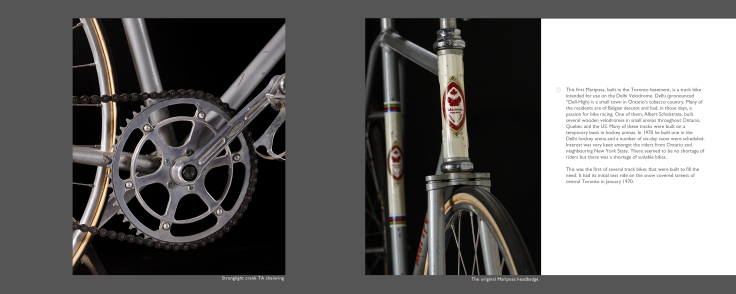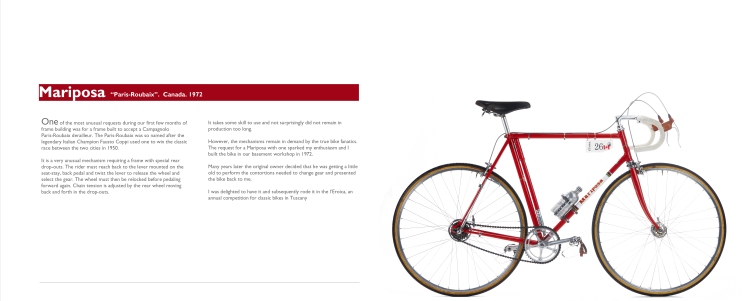Mike Barry was a Canadian cycling legend. He founded of one of Canada’s best bicycle brands, Mariposa, and ran a bicycle shop called Bicycle Specialities for many years in Toronto.
A Life with Bicycles: a collection from 1878 — 2003 is a book that details the incredible bicycle collection of the recently deceased bicycle mensch. The photos are by Walter Lai. His wife Clare, featured in dandyhorse issue 3, said Mike was very, very pleased with Walter’s photos. “Mike always enjoyed writing, researching and thinking about designs of bikes and their use. I had really encouraged him to also consider doing a book or section on derailleurs as he loved the designs of them. …He certainly had an engineering and inquisitive mind. He was very very and pleased with Walters photos.
Mike Barry died on December 29, 2018, at the age of 80 in Toronto.
His son, Michael, a professional cyclist who competed in the Tour de France, said the book project started a few years ago when Walter and his father decided it would be nice to document his collection of bicycles. “He had been writing about them on his blog and found there was a lot of interest in the bicycles, their history, and technical aspects, and thought it would be nice to put them all in a book. Walter was keen to photograph the bikes (as he had previously worked with my father on building the shop website.) Walter is a professional photographer who has done a range of work for different corporations and magazines over the years. He is also a passionate cyclist who rides everywhere, year-round. As you know bicycles played a central role in my father’s life as he had been passionate about them since he was a child. Through the book, he wanted to share some of what he’d learned, some of his stories and some of the history of bicycles,” Michael said, ” And he felt Walter’s photos captured them beautifully.”
Here are just a few of the images from the book A Life with Bicycles, below, interspersed with our interview with photographer Walter Lai along with a couple of excerpts from the book.
How do you feel to have been a part of this creation? To be able to photograph one of the very best bicycle collections in Canada, and perhaps the world?
Walter Lai: I feel honoured that he trusted me to photograph his bikes. Just as importantly, I treasure that as the project went on, we became friends. I got to know his family: Clare, Michael and Dede, as well and Peter and Tom who work in the shop, and everyone that visited. We all shared many special moments.
The community he built is a real testament to his character. He taught me to have an open mind and a non-judgmental attitude in life. He inspired everyone to be the best they could be, and to always keep riding!
One of the first ‘safety bicycles’ in America was the Elliott, below.

Soon after Starley introduced his Rover safety bicycle in 1888 many others companies throughout the World introduced similar machines. One of the earliest American safeties was the Elliott…By 1892 his bicycle company produced a number of safety models all of which were equipped with wooden wheels. They were similar to the wheels fitted to horse drawn wagons of the time with wooden hubs and spokes. It is difficult to understand why the Elliott Company used these wheels when much lighter wire spoked wheels were being used by every other manufacturer. …I purchased this bike from the owner of a bar in Buffalo, New York, where it had been hanging over the bar for many years. ~ from A Life with Bicycles, by Mike Barry
How did you meet Mike?
Walter Lai: About 10 -12 years ago, Marco Sobrevinas introduced me to Mike. At that time Mike was looking for someone to redesign Bicycle Specialties’ web site. I took the job and that was first time we worked together.
Mike and I got along well. Every time I visited the shop I would check out his derailleur collection. We talked about doing a book on the derailleurs, but couldn’t find a simple solution to display them, photographically. A year or so later, that turned into our effort to document his bike collection.
Presenting, “The Invincible” by Coventry Machinist, below. (Did you know that Coventry Machinists was originally the Coventry Sewing Machine Company?)

I find it amazing that it took so long before a chain drive was fitted to a bicycle. Why is it that the high wheel bike remained in production and popular until Starley introduced his Rover safety bike in 1885? By that time there were steam locomotives so it is evident that the technology was known. Was it because cycling was an upperclass pastime and a rider would feel superior mounted so high? There is no doubt that many riders of high wheel bikes looked at the new safeties with some disdain.
The need for the large front wheel was to increase the distance covered per crank revolution. With the cranks mounted on the front axles one crank revolution produced one set distance covered. The only way to increase that distance and increase the speed was to increase diameter of the front wheel. The rider with long legs was able to straddle a larger diameter wheel. This invincible has a 53” front wheel. That is about average. A very tall person could ride a 60”. ~ from A Life with Bicycles, by Mike Barry
Mike Barry founded the bicycle brand Mariposa. Read our article Man of Steel about him in dandyhorse issue 2.
Mariposa number one, below.

How many bikes did you photograph?
Walter Lai: We shot over 50 bikes, more then half of which made it into the book.
Below is the first Mariposa ever built. It is a track bike intended for us on the Delhi Velodrome. Delhi is a small town in Ontario’s tobacco country. A local resident of Belgian descent name Albert Schelstrate, built several wooden velodromes in small areas through Ontario, Quebec, and the US. Many were build on a temporary basis in hockey arenas. In 1970 he build the one in the Delhi hockey arena and a number of six-day races followed. Interest was keen and there was no shortage of rides – but there was a shortage of suitable bikes. This was the first of several track bikes that were built to fill the need.

How long did it take to make the book?
Walter Lai: From our initial brainstorming to printing the final product, it actually took about 10 years. We both had pretty busy schedules at the time, so we just shot here and there when we were both available. I have the impression that Mike had been thinking of doing a book for a while before I met him, so it feels good to know that idea could finally come to fruition.

This Mariposa low profile bicycle above was featured on the cover of dandyhorse issue 2 in a painting by Canadian artist Greg Curnoe, who also owned the bicycle. Curnoe was riding another (his yellow) Mariposa with the London Centennial Wheelers when he was hit from behind and killed.
Mike Barry wrote about his relationship with Greg in dandyhorse issue 2, too.
The bicycle frame below was built on special request to accomodate a special Campagnolo derailleur named after legendary cycling champ, Fausto Coppi. Coppi won Paris-Roubaix in 1950, and is often credited with the famous quote: “Age and treachery will overcome youth and skill.”

What was your favourite moment with Mike from the shoots?
Walter Lai: I loved listening to Mike as he was preparing a bike to be photographed. As he carefully cleaned the dirt from the bike, he would tell me its story. Every single bike had a story. He had lots of bikes so I got to hear lots of stories!
I also loved our afternoon tea breaks. Mike would make tea and bring out cookies and we would just talk about life, about anything and everything. Of course, that often included bikes, too.

The Mariposa Randonneur (81) above, and Mike’s beloved ‘mountain’ bike below.
 Did Mike have a favourite bike?
Did Mike have a favourite bike?
“He had many he loved riding, but his favourite was his black Mariposa which he built for the Raid Pyrenean, a Randonneur event across the Pyrenees from the Atlantic to the Mediterranean—he called it his ‘mountain bike’. He liked it because it was comfortable.” ~ Michael Barry Jr.
About the book:
Mike Barry grew up scouring the bomb sites of the Second World War in London, England for abandoned bike frames and parts. With friends, he would find enough parts to assemble bikes and sell. The proceeds went to buy better parts for their own bikes.
Once in a while, Mike would find some interesting and rare parts, which he always kept. That was the beginning of an extensive bike and component collection, which expanded throughout the years.
A Life with Bicycles includes only the more interesting bicycles in his collection. He chose them because of their distinctive features, which are highlighted in the pages of this book through Mike’s writing and the exquisitely detailed photographs of Walter Lai.
Selected mages with descriptions will be posted on our Instagram account over the following month, be sure to like them there. You can buy the book A Life With Bicycles here.

Leave a comment